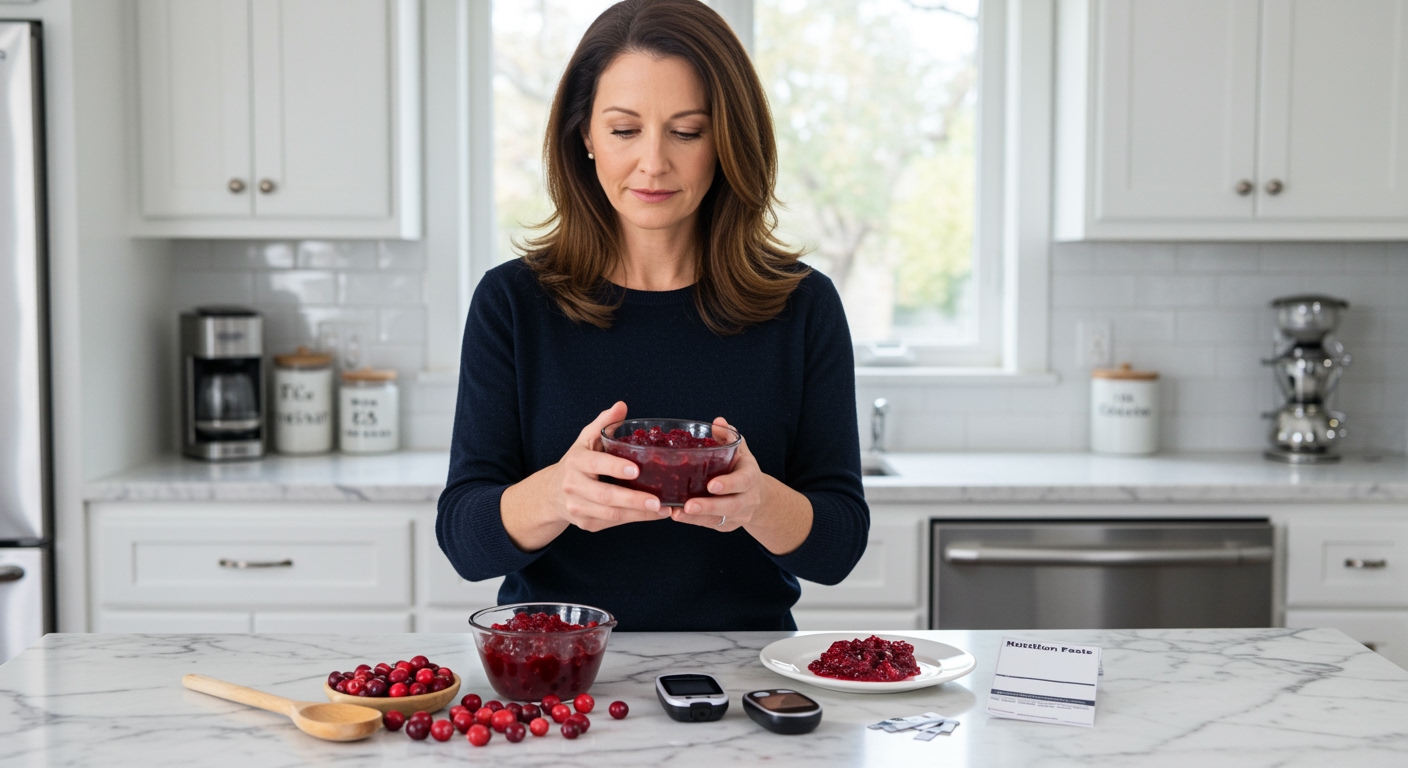✪ Key Takeaway: Cranberry sauce can spike blood sugar due to added sugars, but small portions of homemade versions may be manageable for diabetes.
Introduction
The holiday table looks incomplete without that vibrant red cranberry sauce sitting next to the turkey.
But if you have diabetes, you might be staring at that innocent-looking side dish wondering if it will send your blood sugar through the roof.
Hi, I am Abdur, your nutrition coach and today I am going to explain exactly how cranberry sauce affects your blood sugar and what you need to know to make smart choices.
What Makes Cranberry Sauce A Blood Sugar Concern?
Most commercial cranberry sauces contain a shocking amount of added sugar that can cause rapid blood glucose spikes.
A typical half-cup serving of canned cranberry sauce packs around 22 grams of sugar and has a glycemic index of approximately 45 to 55.
This means your body absorbs the sugar relatively quickly, causing your blood glucose to rise within 15 to 30 minutes after eating.
The problem gets worse because cranberries are naturally very tart and require significant sweetening to make them palatable.
Food manufacturers often use high fructose corn syrup or regular sugar as the primary ingredient, sometimes making up more than 50 percent of the total product weight.
Your pancreas responds to this sugar load by releasing insulin to help cells absorb the glucose from your bloodstream.
If you have diabetes, your body either does not produce enough insulin or cannot use it effectively, leading to prolonged elevated blood sugar levels.
✪ Fact: Fresh cranberries contain only 4 grams of natural sugar per cup compared to 22 grams in half a cup of sauce.
Are There Any Benefits For People With Diabetes?
Despite the sugar concerns, cranberries themselves offer some potential benefits for people managing diabetes.
Fresh cranberries contain powerful antioxidants called proanthocyanidins that may help improve insulin sensitivity and reduce inflammation.
Some research suggests these compounds might help your cells respond better to insulin, though the evidence is still emerging.
Cranberries also provide fiber, which can help slow down sugar absorption and prevent rapid blood glucose spikes.
The fiber works by forming a gel-like substance in your digestive tract that slows the movement of food through your intestines.
However, most commercial cranberry sauces are strained and processed, removing much of the beneficial fiber content that could help moderate blood sugar response.
The high sugar content in prepared sauces typically outweighs any potential benefits from the cranberries themselves.
✪ Pro Tip: Look for whole berry cranberry sauce to get more fiber and nutrients than smooth varieties.
How Much Cranberry Sauce Can You Safely Eat?
Portion control becomes critical when you want to enjoy cranberry sauce without compromising your blood sugar management.
A safe serving size for most people with diabetes would be one to two tablespoons of cranberry sauce, which contains roughly 5 to 10 grams of carbohydrates.
This small amount allows you to enjoy the flavor without causing a significant blood glucose spike, especially when eaten as part of a balanced meal.
The protein and fat from other holiday foods like turkey, nuts, or cheese can help slow down sugar absorption from the cranberry sauce.
Your individual tolerance may vary based on your current blood sugar control, medication regimen, and overall carbohydrate intake for the meal.
Consider testing your blood glucose two hours after eating to see how your body responds to different portion sizes.
This personal data helps you make informed decisions about future servings and adjust your approach based on your unique metabolic response.
✪ Note: Always account for cranberry sauce carbohydrates in your total meal planning and medication timing.
What Are Better Alternatives For Diabetics?
Making your own sugar-free cranberry sauce gives you complete control over ingredients and sweetness levels.
You can use natural sugar substitutes like stevia, erythritol, or monk fruit to create a delicious sauce without the blood sugar impact.
These sweeteners do not raise blood glucose levels because your body processes them differently than regular sugar.
Adding orange zest, cinnamon, or vanilla can enhance the flavor without adding carbohydrates or calories.
Another approach involves mixing fresh cranberries with chopped apples or pears to add natural sweetness while increasing the fiber content.
The pectin in apples helps create a gel-like texture similar to traditional cranberry sauce while providing additional nutrients and slower sugar absorption.
You might also consider cranberry relish made with fresh cranberries, celery, and nuts for a crunchy, lower-sugar alternative that still captures the traditional flavors.
✪ Pro Tip: Freeze homemade sugar-free cranberry sauce in ice cube trays for perfect portion control year-round.
The Bottom Line
Traditional cranberry sauce can cause problematic blood sugar spikes for people with diabetes due to its high added sugar content, but small portions or homemade alternatives can allow you to enjoy this holiday favorite safely.
Smart food choices are about finding balance, not eliminating joy from your plate.
I would love to hear about your experiences with cranberry sauce and diabetes management, or any questions you might have about making healthier holiday food choices in the comments below.
References
At NutritionCrown, we use quality and credible sources to ensure our content is accurate and trustworthy. Below are the sources referenced in creating this article:





